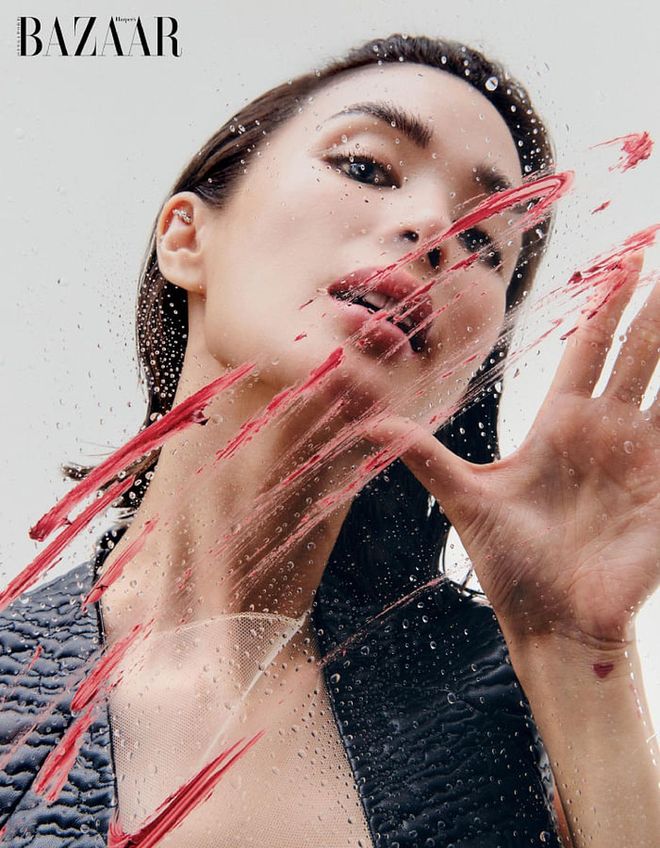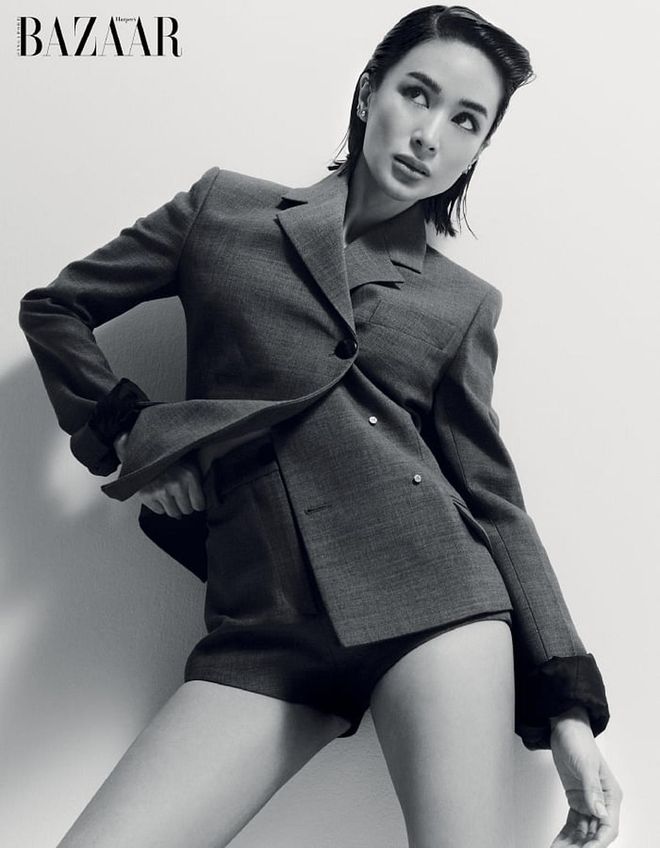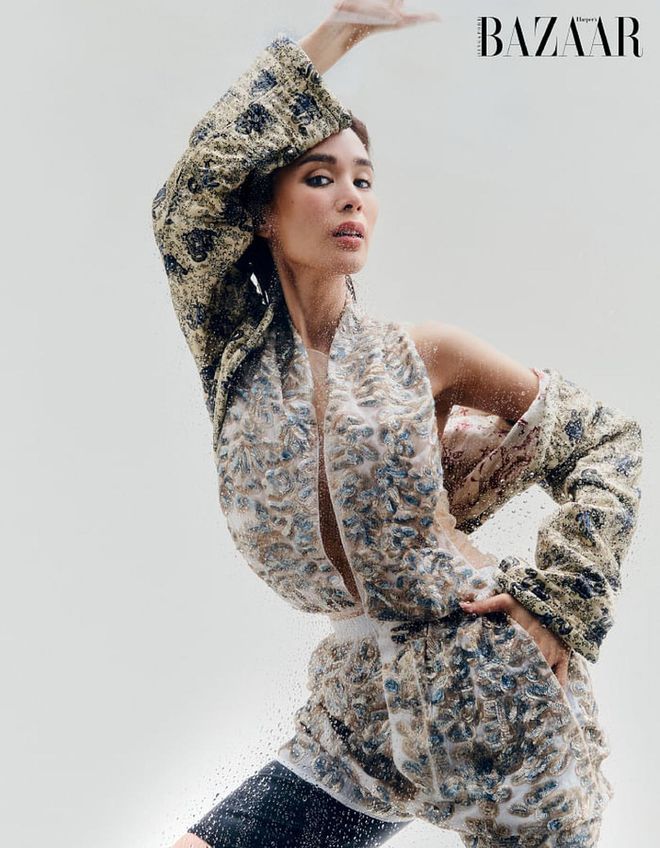Heart Evangelista And EIC Kenneth Goh On Navigating The New World Order Of Fashion
Fashion darling Heart Evangelista and editor-in-chief Kenneth Goh have a wide-ranging tête-à-tête about Asian presence on the global stage and the power of solidarity.

Heart Evangelista needs no introduction at this point, but here it is anyway. In this age of cliched representations of Crazy Rich Asians, she is the real deal—and a true multi-hyphenate to boot. A child star turned household-name actress in her native Philippines, Evangelista is also an haute couture client and a global influencer who sparks a street-style frenzy whenever she hits up Fashion Week. Not only does she have the inside scoop on fashion, she can serve it up from various perspectives.
Related article: Heart Evangelista Is Harper’s BAZAAR Singapore’s December 2023 Cover Star
In a parallel manner, so too does our editor-in-chief, Kenneth Goh, who started out a stylist in the golden age of print, and along the way has become an arbiter, overseer and the thoroughline in the fragmented, multi-channel landscape that the fashion media industry has become. Here, the both of them dive deep into a conversation about their beginnings in fashion, how they’ve seen the industry change, and the amount of thought and, yes, heart they put into the way they navigate the new world order of fashion.

Dress, Louis Vuitton.
When did you first fall in love with fashion?
Heart Evangelista (HE): My dad and mum both loved fashion, and I would see how my mother just looked so glamorous all the time. That was when it started for me. And also, working in the film industry, fashion became a representation of who you are. In the world of all these beautiful people, how do you present yourself? I started in show business when I was 14 and back then, I would actually make my own clothes. For my first portfolio shoot, I was wearing a red shirt and I cut up a cheongsam and stitched it onto the shirt and made myself a matching wristband. I would take a glue gun and put lace on my jeans, add Swarovski crystals to it (laughs). Back then we didn’t have stylists, and I love having my stylists around now, but that was a good exercise in expressing your individuality.
Kenneth Goh (KG): My first brush with fashion was quite strange in the sense that I was dressed by my mum. When I was a kid, she would dress me in shorts with Italian loafers and knee-high socks. This, in Singapore, in the ’70s, was not even a thing. My mum continues to be a style icon for me because of how she embraces all the facets of fashion, and how she truly lives and breathes fashion but in a very real way. She knows what works for her day to day. Right now, she’s commuting to work, which is literally the building next to her house, and she still dresses up. She says, “I have to do that because I want to give myself that process.” That act of dressing up is so important. Growing up looking at her clothes and shoes and accessories inspired me to get into fashion.
By now, you’ve done your fair share of Fashion Weeks. Are there any moments that remain really special to you till this day?
HE: I remember when I used to be seated on the fifth row, and then slowly moved up to the third row. I may look nonchalant about it, but for somebody who loves fashion, it’s really such a big deal for me and I am so grateful to be seated on the front row now with all of these beautiful women.
KG: The highlight for me was probably when fashion houses started doing destination shows, when you travel for Cruise, or for Chanel’s Métier d’Art shows. That was like a whole different experience because you’re fully immersed in that experience for like, four days and three nights. Of course, it was also at a time when social media wasn’t at the pace or ferocity that it is at now. You’re sitting there with your notebook; you didn’t have camera phones, so you’re just capturing the moments with your eyes and you really get to see the clothes.

Jacket; shorts, Ferragamo.
And also back then, inclusivity wasn’t as big a priority in the industry as it is now. It wasn’t a given that Asians would have a seat at the table. What was it like for the both of you navigating that firsthand and seeing things slowly change?
KG: I started doing Fashion Week about 25 years ago, and it was a whole different world. Singapore wasn’t even recognised as a country that consumes fashion—we were just lumped under the general category of Asia. You had to hustle your way in, or beg the PRs just for a standing ticket to the show.
HE: When I started doing Fashion Week, I felt like an outcast, because there weren’t many Asians there. That’s why Kenny stood out. Seeing the way he walked into the shows, the way he dressed, it gave you a sense of confidence as well. Fashion can be so intimidating, but when you see somebody you can relate to, it’s like a map that you can follow.
KG: Thank you, Heart—it means so much to hear you say that. At the same time, I thought that you being photographed at Fashion Week, being acknowledged, being heralded as a style icon from our part of the world, was so powerful. It is wonderful to see that representation.
HE: I think that’s why it’s so important for all Asians to support each other, no matter what region you come from. It always comes back to how we can inspire and nurture each other because in the end, it will all benefit us as a whole. Like, I can’t believe that I am on the BAZAAR cover in Singapore because I am from the Philippines, but that just says one thing: It should be a collective, a celebration of everyone in Asia.

Bolero; bodysuit; shorts, Louis Vuitton.
In addition to the rise of Asia as a force to be reckoned with, the industry is also so different now; most of all in the dominance of social media and in the way that traditional lines have been blurred. How do you see yourself navigating this new world order?
HE: It’s such a business now—it’s all about the numbers, and that can bring so much pressure. But at this point in my life, I’ve been doing a lot of changes on my social media, YouTube, TikTok, everything. I’m very hands-on, and it all goes back to the love for why I do it in the first place. If I love something, I will create a reel for it, whether I’m paid or not. And I think this love will come across to your audience. As for where I see myself headed, I want to try and change things up a bit, to be a bit more creative. With fashion, there are no boundaries of age or how you look—it’s about how you express yourself. I love doing that for myself and I don’t mind translating that for other people as well if they want my help. I think I want to be more on the production side of things.
KG: Would you want to start your own brand, or consult for another brand?
HE: I think I can do that, but I feel like I’m still learning—I don’t think I’m there yet. I’m still getting in my groove, and I want to see where it’ll take me. If you look at influencers, everyone is so creative and so different. But at some point, it became like a machine. You start to worry about your number of likes, about things like shadow banning. So now I’m at that point where it’s like, okay, let’s erase the numbers. I’m just going to be creative, do what I love, and see where that takes me.
KG: That kind of sincerity, trust, one could say naivety, almost—do you find that there is space for that in this industry?
HE: Honestly, there was a time when I felt like there wasn’t. But if you’re really consistent and you work hard—even if you feel like you’re up against a wall and you’re not moving—I really believe that if you truly want it, and keep going for it, it will happen. When you’re shoved to the ground, there’s nowhere else to go but up. Slowly but surely, you will get there.

Jacket, Tod's.
For social media specifically, what do you think it has added to the work that you do, and what has it taken away?
HE: I’m grateful for the pros, which is the reach, the fact that there are no borders; you get to get your message across, become a part of people’s lives. The bad side is when it becomes purely business, and the sad reality is that it has. There’s that line between doing things because they’re sincere and authentic, and doing things because you know they will just work. That, for me, is what I’m struggling with at this point.
KG: I think the increasing reliance on AI, and on facts and figures like EMV [earned media value] has taken out a lot of the beauty of fashion, and the authenticity of fashion. Does a million likes equals something that’s truly desired?
Related article: Heart Evangelista’s Style Evolution Through The Years
What about the celebrity culture that is running rampant in fashion right now, and consequently, the fact that fashion is increasingly becoming yet another pillar of the entertainment industry?
KG: The heavy reliance on celebrity culture to further a brand and make it relevant to an audience—that can work for the brand, but it can also work against it. It can also distract from the actual beauty of fashion. I’ve seen that enormous shift, especially since shows have resumed, across almost all brands. Everyone now wants a celebrity at their show. There has to be a Korean celebrity, there has to be someone from Thailand. This heavy reliance on the power of celebrity—do these celebrities even know how that dress is made? Do they even care how that bag is crafted?
HE: And also, does the audience even care if the person wearing a look has carefully selected it for herself, or if it was just put on her by the PR team? I guess, in a sense, I’m also a celebrity, but I don’t consider myself one. If I put something on, I don’t want it to be staged. I like to be in control of what I wear—it is my main source of joy that I can control. I can’t control my surroundings, but I can control how I feel with how I look.
KG: For me, as an editor who goes to the shows, I see how celebrity culture has completely taken over our social media feeds. I used to do in-depth articles and videos talking about collections—about the fall of a dress, the height of a heel, the length of a hemline. No one cares. It’s all about which celebrity is appearing at which show. The question for me is, where will all this lead to? Does that mean that the brands who shun celebrity—like a lot of the Japanese designers, your Rei Kawakubos—does it mean that their collections are any lesser than a super hype brand that lives purely on celebrity? That is a question that I hope a true fashion audience will ask, and I hope they will be able to circumvent that space. And as a publisher across different platforms, I hope to bring that across these platforms, and maybe slowly shine a light on the area where we hope you come to us for education in a very authentic way.

Blouse; trousers; gloves; bangle, Saint Laurent by Anthony Vaccarello.
With all this noise in the industry that you’ve talked about, how do you make sure that what you create cuts through all that?
HE: I think you just have to keep it as real as possible. I vlog on YouTube and I used to edit certain things out because I didn’t want people to see me swearing, for example. But then I started feeling suffocated. And yes, maybe people see me as a celebrity, but I also want them to see that I am a normal person. So I’ve done a complete shift—you’ll see me doing things you might not expect a “celebrity” to do. It’s hit-or-miss—I might lose a few things, because maybe in my country I might be the first to do this, but at least I’m myself. I’d rather be accepted and loved for being myself, than being a “perfect” person who’s loved a season or two. I would never want to be a hostage to, say, a brand who wants you to look a certain way so they can sell a certain product.
Related article: How To Ace Heart Evangelista’s Everyday Natural Makeup Look
When you work with a brand or a partner, how do you stay true to both yourself and the other party?
HE: I think, first and foremost, you have to make sure that you trust yourself, and that you always have good intentions towards the people you work with and the work that you do. You have to sincerely love what you do. I also need the brand to embrace me for who I am. They don’t have to throw out the red carpet, but I feel appreciated by the simple things, like giving me a choice of what to wear. I don’t think I’ve worked with brands that tell me, ‘Oh, you have to do this reel, and it needs to look this way.’ I usually do up my own boards, and then I show them and ask them if they like it. And most of the time, because they gave me that freedom, they do like it and it turns out better.
KG: I think the thing that has kept me going in fashion is the true emotion that comes from watching creativity happening right in front of our eyes. When you see a paintbrush being taken across a white piece of paper, or a pin being taken through a metre of silk, it is that process that represents creativity at its height. Like on this set for example, I’m pinning the clothes on you, I’m adjusting your hair, I’m adjusting the jeans, the shorts; I’m asking you questions about how that outfit feels on you, how you think it should fit on you. I think that is what is authentic. And that goes back to the crux of what I always say—and will say to my dying day—which is that I am forever a stylist. It’s what I was trained as; it’s what I grew up learning. No matter what title you work for, no matter what position you hold, it is about seeing how the outfit fits on a woman and how it makes her feel.
HE: Exactly. It’s all those little things; it’s how Kenny smeared that lipstick on that piece of glass. That was his vision—that was literally his fingerprint. It’s really about how you make it personal.
KG: On that note, this has been so personal and so special. Thank you, Heart.
HE: Thank you, Kenneth and BAZAAR Singapore!
Editor-in-Chief: Kenneth Goh
Photographer: Shawn Paul Tan
Stylist: Windy Aulia
Fashion: Tods, Ferragamo, Louis Vuitton, Saint Laurent
Interviewer: Annabelle Fernandez
Story: Jeffrey Yan
Hair: Yuhi Kim
Makeup: Memay Francisco
Lash Technician: Meiko Mizuno
Assistant Stylist: Gracia Phang
Photographer’s Assistants: Xie Feng Mao, Chay Wei Kang
Additional Assistance: Larissa Wong